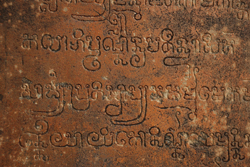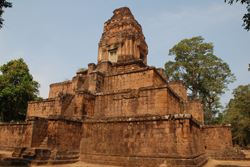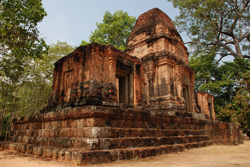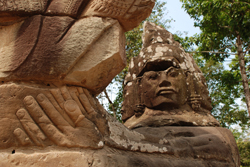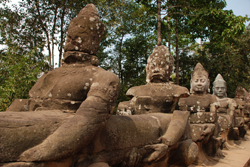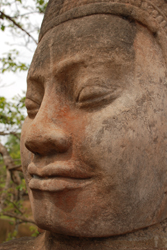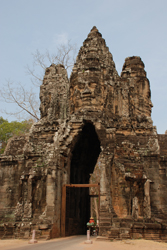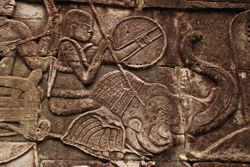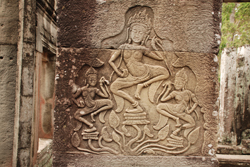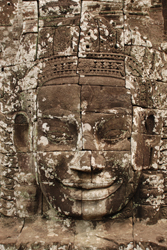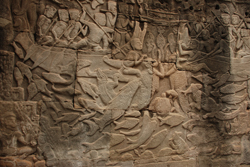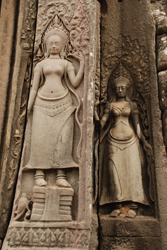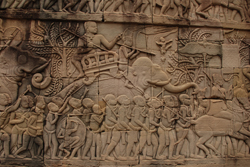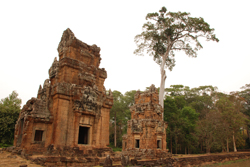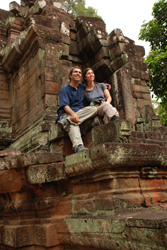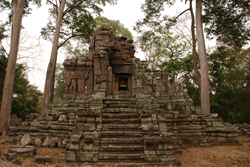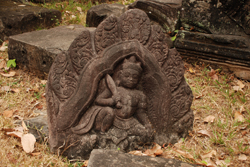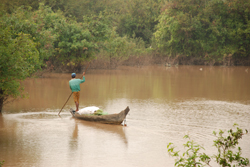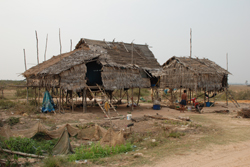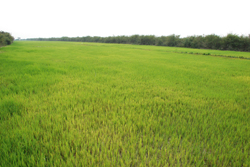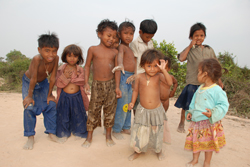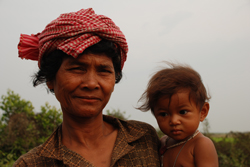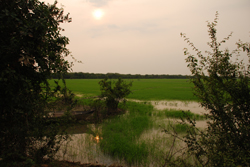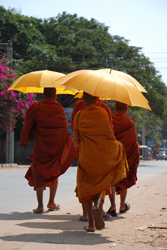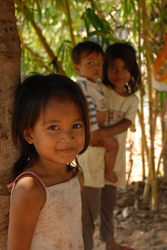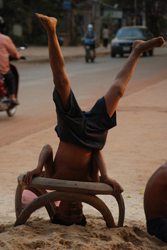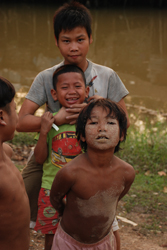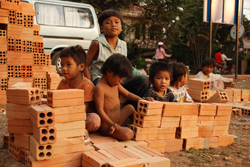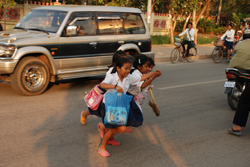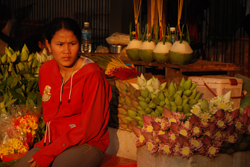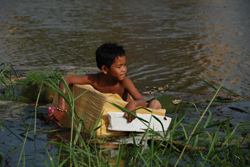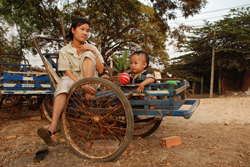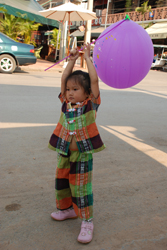Angkor: Biking around Angkor
2 February, 2009, 02:39 am in "Cambodia"
Because we hate being hassled by tuk-tuk drivers (and the price is inflated) we have decided to visit Angkor Historical Park by bike and have rented bikes for a week.
I should probably mention something about what visiting Angkor Wat involves. Angkor Wat is only one of dozens of temples as well as other ruined structures that make up the park which is about 20 km wide and 7 km North to South. 13 km away from the main part of the park is another cluster of ruins called the Roluos group and one more temple, Banteay Srey is 37 km from the park. In the central area (about 3x5 km) there are several famous temples including Angkor Wat. The bulk of the center is made up by Angkor Thom, a 3x3 km walled area which was the Royal City. The main section of Angkor is about 5 km North of Siem Reap.
Biking through Siem Reap to Angkor shows one of the posh sides of town: resorts, the new National Museum, condos, and a new mall. But you still get glimpses of non-glitzy Cambodia. Pick-up trucks packed with people wearing hats and krama scarves over their mouths to protect themselves from dust. People wheel carts with loaves of French bread for sandwiches or pieces of sugar cane. Sometimes you see a man or woman cranking a silver colored machine which presses the sugar cane into juice. Kids run through the streets or play in the river--little boys unabashedly naked. Motors and tuk tuks race down the streets.
I should probably mention something about what visiting Angkor Wat involves. Angkor Wat is only one of dozens of temples as well as other ruined structures that make up the park which is about 20 km wide and 7 km North to South. 13 km away from the main part of the park is another cluster of ruins called the Roluos group and one more temple, Banteay Srey is 37 km from the park. In the central area (about 3x5 km) there are several famous temples including Angkor Wat. The bulk of the center is made up by Angkor Thom, a 3x3 km walled area which was the Royal City. The main section of Angkor is about 5 km North of Siem Reap.
Biking through Siem Reap to Angkor shows one of the posh sides of town: resorts, the new National Museum, condos, and a new mall. But you still get glimpses of non-glitzy Cambodia. Pick-up trucks packed with people wearing hats and krama scarves over their mouths to protect themselves from dust. People wheel carts with loaves of French bread for sandwiches or pieces of sugar cane. Sometimes you see a man or woman cranking a silver colored machine which presses the sugar cane into juice. Kids run through the streets or play in the river--little boys unabashedly naked. Motors and tuk tuks race down the streets.
I was expecting it to be hot biking. So far though it has been incredibly pleasant. Tall trees shade the road-- most of which is paved. Bikes give the added freedom of in some cases biking right up to the monuments.
The temples of Angkor were built from the 9th C. AD until the beginning of the 13th. The monuments were built by a series of Khmer Kings, with Jayavarmon VII being the most prolific as far as monument building goes. The monuments' décor shows the shift between Hinduism and Buddhism (and then back) and reflects different artistic/ architectural styles.
The first monument we visited was Baksei Chaunkrong, a 10th century temple made up of a stone step pyramid with a tower on top, built of large stone blocks, now fairly eroded. To me, the most interesting features were the inscribed doors. The inscription was in beautiful curly Sanskrit and (according to the sign) is about the succession of Khmer kings from even before pre-Angkorian times, grounding the dynasty on a mythical foundation. Sanskrit looks like how space aliens should write.
The temples of Angkor were built from the 9th C. AD until the beginning of the 13th. The monuments were built by a series of Khmer Kings, with Jayavarmon VII being the most prolific as far as monument building goes. The monuments' décor shows the shift between Hinduism and Buddhism (and then back) and reflects different artistic/ architectural styles.
The first monument we visited was Baksei Chaunkrong, a 10th century temple made up of a stone step pyramid with a tower on top, built of large stone blocks, now fairly eroded. To me, the most interesting features were the inscribed doors. The inscription was in beautiful curly Sanskrit and (according to the sign) is about the succession of Khmer kings from even before pre-Angkorian times, grounding the dynasty on a mythical foundation. Sanskrit looks like how space aliens should write.
Sitting on the shady side of the top, I looked down at thick tree-life in various shades of green. One tree was full of tiny white flowers. A cool breeze made the location even more welcoming. Butterflies flew below, many yellow or white but sometimes we saw flashes of blue, purple and orange. Next to Baksei Chaunkrong was the 3 towered Prasat Bei
The bridge to the South Gate was impressive. It is lined with 52 stocky figures on each side and multi headed people in the front and back of each line. All hold a huge naga with the stocky figures gripping the body. The figures had broad flat feet and Buddha like heads. Something about them made me think of Inca or Mayan carvings.
The South Gate was crowned with strange but beatific giant faces. Other carvings included elephants and floral patterns. In the moat, which was swampy on one side, cattle grazed and men picked through the water weeds collecting tubs full of snails or shellfish which they sell on large flat carts in the city.
The Bayon was built by Jayavarma VII. It is filled with extremely well preserved wall bas reliefs. The reliefs circle the whole structure and though most show battles involving armies and elephants, there were also scenes with buildings, people who were perhaps royalty with others bowing to them, boat scenes with lots of fish and a crocodile, musicians, people grinding rice, carts and what looked like a circus. Inside was another set of walls with bas relief murals. These made up the exterior of vaulted stone chambers. Several staircases led upstairs to a second level which was a roof from which tall stone towers rose with the famous carved stone faces-- staring down like detailed Easter Island monoliths. The faces are almost camouflaged by weathering and lichen, making them seem even more mysterious with secret calm smiles.
It took us a while to look at all the carvings. When we'd finished we went to see a set of towers or “prasats” Suor Prat and the North and South Kleangs. Compared to the Bayon, these were rather plain simple buildings lacking ornate carvings (though a few were scattered around).
The Preah Pithu Group temples were mostly built in the 12th century though one was Buddhist so it was probably from the 14th. These were beautiful jungle ruins occupying a quiet spot while a little ways off crowds and tour groups viewed the Terrace of Elephants. The gray stone structures peeked out form behind trees giving the temples a secretive appearance. All around we could hear birds calling. One had some interesting lintel carvings telling the story of “The Churning of the Sea of Milk” and the beheading of the lazy demon Kala.
While all the angels and demons worked to churn the sea of milk to make the drink of eternal life, the lazy demon Kala hid and waited. When the drink was finished, he stole a glass. But the sun and moon saw him and told a female avatar of Vishnu who cut off Kala's head just as he was drinking the potion. His body died but his head became immortal and decorates many of the lintels in Angkor.
Biking to Kampong Phluk
1 February, 2009, 02:39 am in "Cambodia"
We rented bikes and in the afternoon tried to bike to Kampong Phluk but after asking for directions we got tailed by a tout on a moto trying to get us onto a boat.
At first it was a pleasant ride. Once we got off the highway we went through Roluos village, a shady paved road with raised houses on either side. Some seemed new and modern. Others were more basic with palm leaf walls. Some had hammocks underneath where people relaxed, gently swinging. Children yelled out, “Hello!” and “Bye-bye”, waving as we went by.
At first it was a pleasant ride. Once we got off the highway we went through Roluos village, a shady paved road with raised houses on either side. Some seemed new and modern. Others were more basic with palm leaf walls. Some had hammocks underneath where people relaxed, gently swinging. Children yelled out, “Hello!” and “Bye-bye”, waving as we went by.
The river was a muddy stagnant ditch and I couldn't see how a boat could get down it. The paved road ended in a couple km and we were on a dirt road. The traffic of bikes and motos had hardened a path in the otherwise sandy soil. Every house seemed to have a well with pump and a sign about the organization and people who donated it.
The trees became more sparse and the landscape opened into a broad flat plain of dusty blues, browns and greens. We came upon a small village of low stilt houses with palm leaf walls. We were soon surrounded by children waving and saying “hello-bye-bye” I tried to think of another word to teach them. Little girls wore long dirty skirts. Some of the littlest boys wore no clothing at all. Several children found my Teva sandals very interesting. Perhaps they'd only seen flip flops or tennis shoes. A couple may have been begging but fortunately for us they hadn't learned enough English to be annoying.
The trees became more sparse and the landscape opened into a broad flat plain of dusty blues, browns and greens. We came upon a small village of low stilt houses with palm leaf walls. We were soon surrounded by children waving and saying “hello-bye-bye” I tried to think of another word to teach them. Little girls wore long dirty skirts. Some of the littlest boys wore no clothing at all. Several children found my Teva sandals very interesting. Perhaps they'd only seen flip flops or tennis shoes. A couple may have been begging but fortunately for us they hadn't learned enough English to be annoying.
We still had no view of the lake though the river had gotten a little bigger. Suddenly the land turned a bright pristine green as we reached an area full of rice paddies. We kept on. The road because a lot more difficult-- hardened rutted mud or patches of sand. But still, no village. We finally reached some boats as well as our tout who, when Rowshan finally had chased him away, had gone ahead. A bit farther were more boats and the road ended. From there it was necessary to take a boat to the village at $15 person r/t. We thought this was pricey and also it was getting late so we needed to turn back. It was a rough ride back and it was dark by the time we got back to Siem Reap.
Siem Reap: Tourist Guilt
31 January, 2009, 02:39 am in "Cambodia"
I'm suffering from tourist guilt. I'm enjoying the cheap luxury, the cheap food, lounging in cafes with free wireless Internet but the more I question the strangeness of this cheap island of luxury in such a poor country, the more I find out and the more I realize how much I'm contributing to the problem.
According to the UN LDC (least developed countries) list, Cambodia is #8. And Siem Reap is the poorest province in Cambodia. And here we are in the poorest part of one of the poorest countries, lounging in luxury.
I can usually rationalize our tourism because we help small local businesses unlike big package tourists on tours from foreign companies staying in foreign hotel chains. However, here in Cambodia, I'm not sure how many of the businesses are actually owned by locals. Korea and China have a lot of business in the area and. I still haven't found the numbers but I have a feeling all the swank Western looking businesses look Western because they are.
I also found out hotels dump sewage into the river and the water table is in danger of dropping (damaging the Angkor ruins) because there are too many tourists.
I have the uncomfortable feeling the proper thing to do would be flee this area and spend tourist dollars in a less touristy area. But instead we are thinking of getting a week Angkor pass (we still haven't been to the ruins yet). It is a little bit of comfort that there are so many NGO businesses that support education, job training, at risk people, and other projects.
Rowshan and I walked up the river, today. Very quickly the surroundings changed. A row of river shacks popped up beyond a strange net which seemed to be placed to prevent the trash from floating into town-- but maybe these are for another purpose. We saw some kids playing with bricks by the river. A woman was photographing them. Kids playing by the river seem to always have a photographer near them here.
According to the UN LDC (least developed countries) list, Cambodia is #8. And Siem Reap is the poorest province in Cambodia. And here we are in the poorest part of one of the poorest countries, lounging in luxury.
I can usually rationalize our tourism because we help small local businesses unlike big package tourists on tours from foreign companies staying in foreign hotel chains. However, here in Cambodia, I'm not sure how many of the businesses are actually owned by locals. Korea and China have a lot of business in the area and. I still haven't found the numbers but I have a feeling all the swank Western looking businesses look Western because they are.
I also found out hotels dump sewage into the river and the water table is in danger of dropping (damaging the Angkor ruins) because there are too many tourists.
I have the uncomfortable feeling the proper thing to do would be flee this area and spend tourist dollars in a less touristy area. But instead we are thinking of getting a week Angkor pass (we still haven't been to the ruins yet). It is a little bit of comfort that there are so many NGO businesses that support education, job training, at risk people, and other projects.
Rowshan and I walked up the river, today. Very quickly the surroundings changed. A row of river shacks popped up beyond a strange net which seemed to be placed to prevent the trash from floating into town-- but maybe these are for another purpose. We saw some kids playing with bricks by the river. A woman was photographing them. Kids playing by the river seem to always have a photographer near them here.
When they saw Rowshan several ran to him and hugged his legs. I watched to see if any pick-pocketing was going on but they just seemed glad to see him. He had met them the previous day when he was out photographing. They posed and Rowshan took some more photos.
Powered by My Blog 1.69. Copyright 2003-2006 FuzzyMonkey.net.
Created by the scripting wizards at FuzzyMonkey.net..
(Code modified by Rowshan Dowlatabadi)
Created by the scripting wizards at FuzzyMonkey.net..
(Code modified by Rowshan Dowlatabadi)




